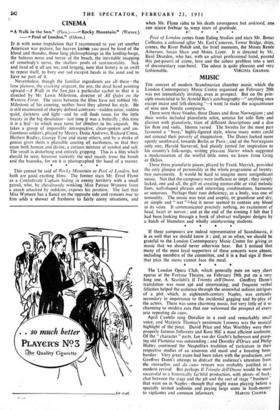MUSIC
THE concert of modern Scandinavian chamber music which the London Contemporary Music Centre organised on February 20th was not immediately inviting, even in prospect. But on the prin- ciple enunciated in Sir Arnold Bax's autobiography—" anything once except incest and folk-dancing "-1 went to make the acquaintance of nine new Nordic composers.
There were three Swedes, three Danes and three Norwegians ; and their works included pianoforte solos, sonatas for solo flute and clarinet with pianoforte, trios of different descriptions and a duo for flute and viola. Idioms varied. The Swedes for the most part favoured a " busy," highly-figured style, whose many notes could not conceal their poverty of imagination. The Danes looked more openly southward, towards Berlin or Paris ; and of the Norwegians only one, Harald Saeverud, had plainly turned for inspiration to his country's folk-songs, writing pleasant Natter which suggested a modernisation of the wistful little tunes we know from Grieg or Delius.
These three pianoforte pieces, played by Frank Merrick, provided the only glimpse of personality in the whole programme of twenty- two movements. It would be hard to imagine more unsignificant music. Not that the composers were inefficient or inept ; they simply lacked, one and all, the gift of creating memorable or vital melodic lines, well-shaped phrases and interesting combinations, harmonic or sonorous. Perhaps their root deficiency, as a body, was one of sensuality. The music was neat and aseptic, or grandiose and dry, or simple and " wet "-but it never seemed to contain any blood in its veins. It communicated precisely nothing, no excitement of head, heart or nerves ; and at the end of the evening I felt that I had been looking through a book of abstract wallpaper designs by a batch of blameless and wholly uninteresting students.
If these composers are indeed representative of Scandinavia, it is as well that we should know it ; and, as so often, we should be grateful to the London Contemporary Music Centre for giving us music that we should never otherwise hear. But I noticed that many of the most loyal supporters of these concerts were absent, including members of the committee, and it is a bad sign if those that plan the menu cannot face the meal.
The London Opera Club, which generally puts on very short operas at the Fortune Theatre, on February 19th put on a very long one, A. Scarlatti's 11 Trionfo dell'Onore. Geoffrey Dunn's translation was most apt and entertaining, and frequent verbal felicities helped the audience through the somewhat tedious intrigues of a plot which, in eighteenth-century Naples, was certainly secondary in importance to the incidental gagging and by-play of the actors. There was some charming music, but very little of it so charming to modern ears that one welcomed the prospect of every aria repeating da capo.
April Cantelo sang Doralice in a cool and remarkably small voice, and Marjorie Thomas's passionate Leonora was the musical highlight of the piece. David Price and Max Worthley were their properly fatuous followers and Rose Hili a most efficient soubrette. Of the " character " parts. Jan van der Gucht's lecherou's and grasp- ing old Flaminio was outstanding ; and Dorothy d'Orsay and Philip Hattey continued the Neapolitan tradition of caricature in their respective studies of an amorous old maid and a boasting bom- bardier. Very great pains had been taken with the production, and Geoffrey Dunn's attempt to distract the audience's attention from the ritornellos and da moo repeats was probably justified in a modern revival. But perhaps I! Trionfo dell'Onore would be most successful in a historically faithful production, with plenty of back-. chat between the stage and the pit and the sort of stage " business ' that went on in Naples—though that might mean playing before a specially invited audience and paying large sums in hush-money






































 Previous page
Previous page